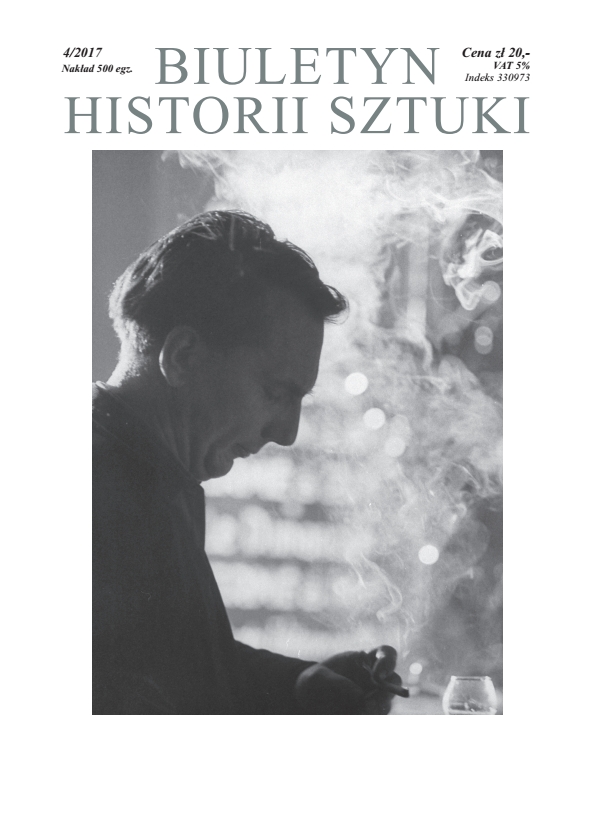Dobry artysta i zły marszand albo odwrotnie. O związkach Jana Lebensteina z nowojorską Galeria Chalette
A Good Artist and a Bad Art Dealer, or Vice Versa. On Jan Lebenstein’s Relations with New York’s Galerie Chalette
Author(s): Konrad NiemiraSubject(s): Fine Arts / Performing Arts, Visual Arts, Sociology of Art
Published by: Instytut Sztuki Polskiej Akademii Nauk
Keywords: New York's art dealers; Galerie Chalette, New York; Jan Lebenstein; Artur Lejwa;
Summary/Abstract: Konrad Niemira, A Good Artist and a Bad Art Dealer, or Vice Versa. On Jan Lebenstein.s Relations with New York.s Galerie Chalette The contacts that Jan Lebenstein had in 1959-74 with the Galerie Chalette run by Artur and Madeleine Lejwa are discussed. The reconstruction and interpretation of those turbulent relations between Jan Lebenstein and the gallery were conducted on the grounds of the documents from the Gallery's archive that are currently at the American Art Archives, Smithsonian Institution, Washington DC. The used sources had previously remained unknown to Polish researchers. Jan Lebenstein may have met Artur Lejwa in the spring and summer of 1959 during the trip of the latter to Poland. The middleman in the meeting was most likely Ryszard Stanis³awski, who trough the Office of Foreign Trade organized export of Polish art to Western Europe and the United States. Theartist started constant cooperation with the Galerie Chaletter only once he had migrated, namely when extremely successful following the Biennale of the Young in Paris, he settled down in France. In September 1961, the painter signed an exclusivity contract with Lejwa for trading his art in the US. This was the time when works on the artist's monographic exhibition in the United States had begun. The first problems in the cooperation arosealready in February 1962. The artist wanted then to sell paintings bypassing the Gallery, this causing thedealer.s protest. The dispute also covered the range of the activities of the dealer representing Lebensteinin France, namely Jacquesa Lacloche. Despite these difficulties, the opening of the artist.s exhibition,planned for March 1962, was held at the Gallery as scheduled, while the painter graced it with his presence. Lebenstein.s visit to the USA, meant by Lejwa as help to the marketing activities he was involved in, proved to be a failure. Lebenstein apparently (as reported by Lejwa) showed up in some company and having drunk, he behaved inappropriately. Upon the artist.s return to Paris, the cooperation became even harder. The dealer did not inform the artist about the sales of his works, while Lebenstein did not fulfill the Contract commitment of supplying a definite number paintings. In July 1963, Lebenstein decided to breach his Contract with the Gallery. For several months Lejwa ignored the correspondence on the topic, that is why in 1965 the case ended up in court. For the next decade the court failed to rule, while Lebenstein.s career was in stalemate. The conflict was resolved by the agreement between the Parties only in 1974, already after Lejwa.s death. Although the figure of the «bad art dealer» as well as the aversion to laws ruling in the art market were reiterated in Lebenstein's statements, these have never before been confronted with the artist's personal experience and the fact that the litigation with his former representative went on for over a decade. The purpose of the article, however, is not ablack-and-white accounting for Lebenstein's dislike of American art dealers. A critical analysis of the sources allow to find nuances in the dichotomy the artist was building: good artist - bad art dealer. In the course of the litigation Lejwa accused Lebenstein of cheating the French government over taxes, of not complying with the Contract as for the annual number of works he was to supply to the Gallery, and finally that any business cooperation with him was difficult due to his alcoholism. However, other Polish artists (e.g. Wojciech Fangor) cooperating with Artur Lejwa highly appreciated the dealer's professionalism and logistics skills, Lebensteinbeing the only Pole in open conflict with the Galerie Chalette.s owner. The presentation of the course of the events and arguments of both parties inevitably questions Lebenstein.s version of the story and makes one perceive it as an attempt at a quasiromantic narrativzation of history.Translated by Magdalena Iwińska
Journal: Biuletyn Historii Sztuki
- Issue Year: 79/2017
- Issue No: 4
- Page Range: 777-796
- Page Count: 20
- Language: Polish
- Content File-PDF

